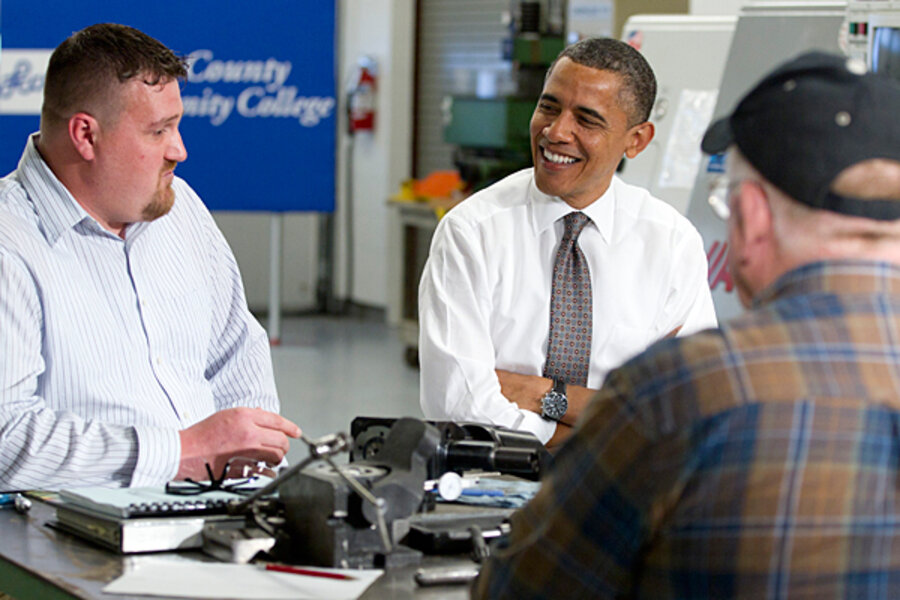Student loans: Obama's bid to rekindle 'Yes We Can' among youths
| Washington
Young voters were a crucial piece of Barack Obama’s victory four years ago, and they support him again for reelection. So why is the president spending much of this week reaching out to younger Millennial voters (those between 18 and 24) over student loans?
The reason is that there’s a chance young voters won’t turn out in large enough numbers to overcome Mr. Obama’s deficits among other demographic groups.
Obama is traveling Tuesday and Wednesday to three universities in three battleground states – North Carolina, Colorado, and Iowa – to press Congress to extend a law that cuts interest rates on student loans. Otherwise, on July 1, rates on some loans will double, from 3.4 percent to 6.8 percent.
Americans now owe more on student loans than they do on their credit cards, a bubble that some economists warn has a dampening effect on the economy. Higher rates would only worsen the burden.
Since last Friday, Team Obama has been pounding the student-loan theme. In a conference call Monday, the Obama campaign denied concern about the youth vote, then pivoted to an attack on the president’s likely opponent, Mitt Romney.
“Governor Romney has proposed huge tax cuts for the rich and for corporations,” said James Kvaal, the Obama campaign policy director. “And that has left him with no choice but to support higher rates on student loans, with deep cuts into Pell Grant scholarships [and] with the elimination of the American opportunity tax credit.”
But Romney, at a campaign stop Monday in Aston, Pa., said he supports the extension of low interest rates on student loans.
Obama’s appearances at the University of North Carolina, Chapel Hill; the University of Colorado, Boulder; and the University of Iowa, Iowa City, will all produce news footage of cheering college students, reminiscent of the “Yes We Can” excitement of four years ago. But polls show that while Obama leads Romney among 18- to 34-year-olds – 60 percent to 34 percent in the latest NBC News/Wall Street Journal survey – enthusiasm about voting among the youngest demographic is down from four years ago.
In April 2008, 63 percent of the youngest age cohort was highly interested in the election, compared with just 45 percent now, NBC News reports.
College students are known for being hard to nail down. It can be hard to get them to register to vote, and they often live away from where they’re registered. If they don’t live where they’re registered, they have to vote absentee, which takes effort.
A recent survey of college-age Millennials (ages 18-24) finds that while 61 percent are registered to vote, fewer than half (46 percent) say they are “absolutely certain” to vote in November. A plurality (45 percent) of these younger Millennials self-identify as political independents, compared with 33 percent who identify as Democrats and 23 percent as Republicans, according to the poll by the Public Religion Research Institute and the Berkley Center for Religion, Peace, and World Affairs.
When “leaners” are pushed to choose a side, the breakdown is 58 percent Democratic and 39 percent Republican. But when the choice in November is Obama and a generic Republican, Obama has only a seven-point lead, 48 percent to 41 percent.
The Republican National Committee derided Obama’s push on student loans, saying it’s coming now only because it’s an election year.
“President Obama’s policies have failed students and recent college grads, who face skyrocketing tuitions and diminishing job prospects,” RNC spokeswoman Kirsten Kukowski said Monday in a statement. “In 3.5 years in office President Obama has done nothing as student debt and tuition rates have soared while about half of college grads under 25 are unemployed or underemployed.”
If the student-loan rate goes up, more than 7 million students will pay on average $1,000 more in costs over the life of their loan, said Education Secretary Arne Duncan last Friday at a press briefing.
The Associated Press points out that while Obama blames Republicans for voting against measures to help make college more affordable, it was House Democrats who cut interest rates on student loans in 2007 and set the expiration for this summer, setting up an election-year issue.





